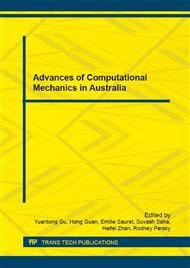[1]
M. Cortie, Ferritic stainless steels, in: Encyclopedia of Materials: Science and Technology, (2001) 3037-3039.
DOI: 10.1016/b0-08-043152-6/00543-x
Google Scholar
[2]
S. Lee, D. Suh, S. Oh and W. Jin, Sticking Mechanism during Hot Rolling of Two Stainless Steels, Metallurgical and Materials Transactions A. 29A (1998) 696-702.
DOI: 10.1007/s11661-998-0151-9
Google Scholar
[3]
W. Jin, J. -Y. Choi and Y. -Y. Lee, Effect of roll and rolling temperatures on sticking behavior of ferritic stainless steels, ISIJ International. 38 (1998) 739-743.
DOI: 10.2355/isijinternational.38.739
Google Scholar
[4]
J. -x. Liu, Y. -j. Zhang and J. -t. Han, Test research on sticking mechanism during hot rolling of SUS 430 ferritic stainless steel, International Journal of Minerals, Metallurgy, and Materials. 17 (2010) 573-578.
DOI: 10.1007/s12613-010-0359-8
Google Scholar
[5]
C. Kim, Y. Kim, J. Park, S. Lee, N. Kim and J. Yang, Effects of alloying elements on microstructure, hardness, and fracture toughness of centrifugally cast high-speed steel rolls, Metallurgical and Materials Transactions A. 36 (2005) 87-97.
DOI: 10.1007/s11661-005-0141-0
Google Scholar
[6]
D. J. Ha, H. K. Sung, S. Lee, J. S. Lee and Y. D. Lee, Analysis and prevention of sticking occurring during hot rolling of ferritic stainless steel, Materials Science and Engineering: A. 507 (2009) 66-73.
DOI: 10.1016/j.msea.2008.11.062
Google Scholar
[7]
S. Q. A. Rizvi, A Comprehensive Review of Lubricant Chemistry, Technology, Selection, and Design, ASTM International, (2009).
Google Scholar
[8]
L. Hao, Z. Jiang, D. Wei, Y. Zhao, J. Zhao, M. Luo, L. Ma, S. Luo and L. Jiang, Effect of extreme pressure agents on the anti-scratch behaviour of high-speed steel material, Tribology International. 81 (2015) 19-28.
DOI: 10.1016/j.triboint.2014.07.009
Google Scholar
[9]
L. Hao, Z. Jiang, X. Cheng, J. Zhao, D. Wei, L. Jiang, S. Luo, M. Luo and L. Ma, Effect of extreme pressure additives on the deformation behavior of oxide scale during the hot rolling of ferritic stainless steel strips, Tribology Transactions. (2015).
DOI: 10.1080/10402004.2015.1025931
Google Scholar
[10]
Z. Y. Jiang, A. K. Tieu, W. H. Sun, J. N. Tang and D. B. Wei, Characterisation of thin oxide scale and its surface roughness in hot metal rolling, Materials Science and Engineering: A. 435–436 (2006) 434-438.
DOI: 10.1016/j.msea.2006.07.070
Google Scholar
[11]
J. Tang, A. K. Tieu and Z. Y. Jiang, Modelling of oxide scale surface roughness in hot metal forming, Journal of Materials Processing Technology. 177 (2006) 126-129.
DOI: 10.1016/j.jmatprotec.2006.04.105
Google Scholar
[12]
M. Krzyzanowski and J. H. Beynon, Modelling the Behaviour of Oxide Scale in Hot Rolling, ISIJ International. 46 (2006) 1533-1547.
DOI: 10.2355/isijinternational.46.1533
Google Scholar
[13]
Y. Yu and J. G. Lenard, Estimating the resistance to deformation of the layer of scale during hot rolling of carbon steel strips, Journal of Materials Processing Technology. 121 (2002) 60-68.
DOI: 10.1016/s0924-0136(01)01176-1
Google Scholar
[14]
M. F. Frolish, M. Krzyzanowski, W. M. Rainforth and J. H. Beynon, Oxide scale behaviour on aluminium and steel under hot working conditions, Journal of Materials Processing Technology. 177 (2006) 36-40.
DOI: 10.1016/j.jmatprotec.2006.03.224
Google Scholar
[15]
N. J. Mosey, M. H. Müser and T. K. Woo, Molecular Mechanisms for the Functionality of Lubricant Additives, Science. 307 (2005) 1612-1615.
DOI: 10.1126/science.1107895
Google Scholar
[16]
N. J. Mosey, T. K. Woo, M. Kasrai, P. R. Norton, G. M. Bancroft and M. H. Müser, Interpretation of experiments on ZDDP anti-wear films through pressure-induced cross-linking, Tribology Letters. 24 (2006) 105-114.
DOI: 10.1007/s11249-006-9040-9
Google Scholar


